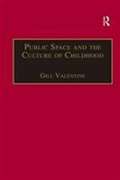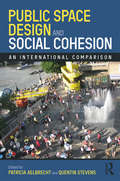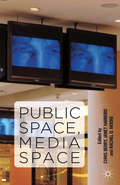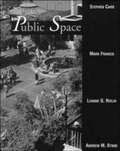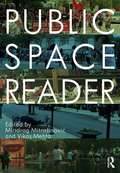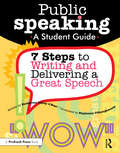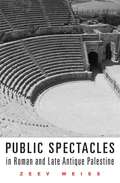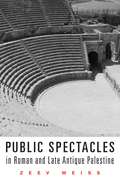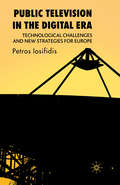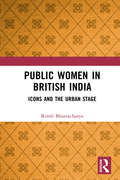- Table View
- List View
Public Space: notes on why it matters, what we should know, and how to realize its potential
by Vikas MehtaPublic Space: notes on why it matters, what we should know, and how to realize its potential journeys a vast territory and presents a panoramic view of public space—an understanding from numerous disciplines—under one cover in an incisive and concise manner. As a dialogue between the social-political and the material-physical, the book brings together the key ideas that encompass the social, political, and physical issues in the making and experience of public space. The book is at the same time a primer and a progressive text. It makes the case for public space, digs deep into understanding what public space is, followed by three sections that present the inherent paradoxes, the possibilities, and propositions for a more meaningful public space. The book presents ideas in concise and approachable ways—from established tenets to new propositions—that are constructive and thought-provoking, with many that will challenge the reader’s preconceived notions. Students and scholars in the built environment disciplines and social sciences, public space managers, public and private sector practitioners, and civic leaders, but also residents who want to better understand and make an impact in their communities and cities will find Public Space to be a valuable resource.
Public Space: notes on why it matters, what we should know, and how to realize its potential
by Vikas MehtaPublic Space: notes on why it matters, what we should know, and how to realize its potential journeys a vast territory and presents a panoramic view of public space—an understanding from numerous disciplines—under one cover in an incisive and concise manner. As a dialogue between the social-political and the material-physical, the book brings together the key ideas that encompass the social, political, and physical issues in the making and experience of public space. The book is at the same time a primer and a progressive text. It makes the case for public space, digs deep into understanding what public space is, followed by three sections that present the inherent paradoxes, the possibilities, and propositions for a more meaningful public space. The book presents ideas in concise and approachable ways—from established tenets to new propositions—that are constructive and thought-provoking, with many that will challenge the reader’s preconceived notions. Students and scholars in the built environment disciplines and social sciences, public space managers, public and private sector practitioners, and civic leaders, but also residents who want to better understand and make an impact in their communities and cities will find Public Space to be a valuable resource.
Public Space And The Culture Of Childhood
by Gill ValentineChildren are at the heart of popular and public debates in North America and Europe about the culture of public space. On the one hand there is increased anxiety about children's vulnerability to stranger danger, on the other there is a rising tide of fear about out of control and dangerous youth. This book addresses both these debates about children's role in public space, setting them within an academic framework and drawing on a range of interdisciplinary work on childhood, young people and parenting. It is therefore relevant to practitioners and policy makers concerned with the nature and future of public space, and to academics researching or teaching about childhood, family or public space in the disciplines of sociology, social policy and geography
Public Space And The Culture Of Childhood (PDF)
by Gill ValentineChildren are at the heart of popular and public debates in North America and Europe about the culture of public space. On the one hand there is increased anxiety about children's vulnerability to stranger danger, on the other there is a rising tide of fear about out of control and dangerous youth. This book addresses both these debates about children's role in public space, setting them within an academic framework and drawing on a range of interdisciplinary work on childhood, young people and parenting. It is therefore relevant to practitioners and policy makers concerned with the nature and future of public space, and to academics researching or teaching about childhood, family or public space in the disciplines of sociology, social policy and geography
Public Space and Relational Perspectives: New Challenges for Architecture and Planning
by Chiara Tornaghi Sabine KnierbeinTraditional approaches to understand space tend to view public space mainly as a shell or container, focussing on its morphological structures and functional uses. That way, its ever-changing meanings, contested or challenged uses have been largely ignored, as well as the contextual and on-going dynamics between social actors, their cultures, and struggles. The key role of space in enabling spatial opportunities for social action, the fluidity of its social meaning and the changing degree of "publicness" of a space remain unexplored fields of academic inquiry and professional practice. Public Space and Relational Perspectives offers a different understanding of public spaces in the city. The aim of the book is to (re)introduce the lived experiences in public life into the teaching curricula of those academic disciplines which deal with public space and the built environment, such as architecture, planning and urban design, as well as the social sciences. The book presents conceptual, practical and research challenges and brings together findings from activists, practitioners and theorists. The editors provide eight educational challenges that educators can endorse when training future practitioners and researchers to accept and to engage with the social relations that unfold in and through public space. Cover image: KARO*
Public Space and Relational Perspectives: New Challenges for Architecture and Planning
by Chiara Tornaghi Sabine KnierbeinTraditional approaches to understand space tend to view public space mainly as a shell or container, focussing on its morphological structures and functional uses. That way, its ever-changing meanings, contested or challenged uses have been largely ignored, as well as the contextual and on-going dynamics between social actors, their cultures, and struggles. The key role of space in enabling spatial opportunities for social action, the fluidity of its social meaning and the changing degree of "publicness" of a space remain unexplored fields of academic inquiry and professional practice. Public Space and Relational Perspectives offers a different understanding of public spaces in the city. The aim of the book is to (re)introduce the lived experiences in public life into the teaching curricula of those academic disciplines which deal with public space and the built environment, such as architecture, planning and urban design, as well as the social sciences. The book presents conceptual, practical and research challenges and brings together findings from activists, practitioners and theorists. The editors provide eight educational challenges that educators can endorse when training future practitioners and researchers to accept and to engage with the social relations that unfold in and through public space. Cover image: KARO*
Public Space and the Challenges of Urban Transformation in Europe
by Ali Madanipour Sabine Knierbein Aglaée DegrosEuropean cities are changing rapidly in part due to the process of de-industrialization, European integration and economic globalization. Within those cities public spaces are the meeting place of politics and culture, social and individual territories, instrumental and expressive concerns. Public Space and the Challenges of Urban Transformation in Europe investigates how European city authorities understand and deal with their public spaces, how this interacts with market forces, social norms and cultural expectations, whether and how this relates to the needs and experiences of their citizens, exploring new strategies and innovative practices for strengthening public spaces and urban culture. These questions are explored by looking at 13 case studies from across Europe, written by active scholars in the area of public space and organized in three parts: strategies, plans and policies multiple roles of public space and everyday life in the city. This book is essential reading for students and scholars interested in the design and development of public space. The European case studies provide interesting examples and comparisons of how cities deal with their public space and issues of space and society.
Public Space and the Challenges of Urban Transformation in Europe
by Ali Madanipour Sabine Knierbein Aglaée DegrosEuropean cities are changing rapidly in part due to the process of de-industrialization, European integration and economic globalization. Within those cities public spaces are the meeting place of politics and culture, social and individual territories, instrumental and expressive concerns. Public Space and the Challenges of Urban Transformation in Europe investigates how European city authorities understand and deal with their public spaces, how this interacts with market forces, social norms and cultural expectations, whether and how this relates to the needs and experiences of their citizens, exploring new strategies and innovative practices for strengthening public spaces and urban culture. These questions are explored by looking at 13 case studies from across Europe, written by active scholars in the area of public space and organized in three parts: strategies, plans and policies multiple roles of public space and everyday life in the city. This book is essential reading for students and scholars interested in the design and development of public space. The European case studies provide interesting examples and comparisons of how cities deal with their public space and issues of space and society.
Public Space Design and Social Cohesion: An International Comparison
by Patricia Aelbrecht Quentin StevensSocial cohesion is often perceived as being under threat from the increasing cultural and economic differences in contemporary cities and the increasing intensity of urban life. Public space, in its role as the main stage for social interactions between strangers, clearly plays a role in facilitating or limiting opportunities for social cohesion. But what exactly is social cohesion, how is it experienced in the public realm, and what role can the design of city spaces have in supporting or promoting it? There are significant knowledge gaps between the social sciences and design disciplines and between academia and practice, and thus a dispersed knowledge base that currently lacks nuanced insight into how urban design contributes to social integration or segregation. This book brings together scholarly knowledge at the intersection of public space design and social cohesion. It is based on original scholarly research and a depth of urban design practice, and analyses case studies from a variety of cities and cultures across the Global North and Global South. Its interdisciplinary, cross-cultural analysis will be of interest to academics, students, policymakers and practitioners engaged with a range of subject areas, including urban design, urban planning, architecture, landscape, cultural studies, human geography, social policy, sociology and anthropology. It will also have significant appeal to a wider non-academic readership, given its topical subject matter.
Public Space Design and Social Cohesion: An International Comparison
by Patricia Aelbrecht Quentin StevensSocial cohesion is often perceived as being under threat from the increasing cultural and economic differences in contemporary cities and the increasing intensity of urban life. Public space, in its role as the main stage for social interactions between strangers, clearly plays a role in facilitating or limiting opportunities for social cohesion. But what exactly is social cohesion, how is it experienced in the public realm, and what role can the design of city spaces have in supporting or promoting it? There are significant knowledge gaps between the social sciences and design disciplines and between academia and practice, and thus a dispersed knowledge base that currently lacks nuanced insight into how urban design contributes to social integration or segregation. This book brings together scholarly knowledge at the intersection of public space design and social cohesion. It is based on original scholarly research and a depth of urban design practice, and analyses case studies from a variety of cities and cultures across the Global North and Global South. Its interdisciplinary, cross-cultural analysis will be of interest to academics, students, policymakers and practitioners engaged with a range of subject areas, including urban design, urban planning, architecture, landscape, cultural studies, human geography, social policy, sociology and anthropology. It will also have significant appeal to a wider non-academic readership, given its topical subject matter.
Public Space, Media Space
by Chris Berry, Janet Harbord and Rachel MoorePublic Space, Media Space asks how media saturation are transforming public space and our experience of it. From the role of graffiti and Youtube videos of street art in the Cairo revolution, to OOH (Out of Home) advertising, the book is diverse in its approach and global in its coverage.
Public Space (Environment And Behavior Ser.)
by Stephen Carr Mark Francis Leanne G. Rivlin Andrew M. Stone Irwin Altman Daniel StokolsThis book reveals the social basis for public space use, design and management. The authors - an architect/environmental designer, a landscape architect, an environmental psychologist, and an open space administrator - offer a well-integrated perspective of how to integrate public space and public life. They contend that three critical human dimensions should guide the process of design and management of public space: the users' essential needs, their spatial rights, and the meanings they seek. To develop and explain these three dimensions, the authors draw on the history of public life and public space, evidence from recent social research, and a series of original case studies, all amply illustrated. Public Space offers an innovative approach for adapting the dimensions to the unique social and environmental context of each project.
Public Space Reader
by Miodrag Mitrasinovi 263 Vikas MehtaRecent global appropriations of public spaces through urban activism, public uprising, and political protest have brought back democratic values, beliefs, and practices that have been historically associated with cities. Given the aggressive commodification of public re- sources, public space is critically important due to its capacity to enable forms of public dis- course and social practice which are fundamental for the well-being of democratic societies. Public Space Reader brings together public space scholarship by a cross-disciplinary group of academics and specialists whose essays consider fundamental questions: What is public space and how does it manifest larger cultural, social, and political processes? How are public spaces designed, socially and materially produced, and managed? How does this impact the nature and character of public experience? What roles does it play in the struggles for the just city, and the Right to The City? What critical participatory approaches can be employed to create inclusive public spaces that respond to the diverse needs, desires, and aspirations of individuals and communities alike? What are the critical global and comparative perspectives on public space that can enable further scholarly and professional work? And, what are the futures of public space in the face of global pandemics, such as COVID-19? The readers of this volume will be rewarded with an impressive array of perspectives that are bound to expand critical understanding of public space.
Public Space Reader
by Mitrašinović Miodrag Mehta VikasRecent global appropriations of public spaces through urban activism, public uprising, and political protest have brought back democratic values, beliefs, and practices that have been historically associated with cities. Given the aggressive commodification of public re- sources, public space is critically important due to its capacity to enable forms of public dis- course and social practice which are fundamental for the well-being of democratic societies. Public Space Reader brings together public space scholarship by a cross-disciplinary group of academics and specialists whose essays consider fundamental questions: What is public space and how does it manifest larger cultural, social, and political processes? How are public spaces designed, socially and materially produced, and managed? How does this impact the nature and character of public experience? What roles does it play in the struggles for the just city, and the Right to The City? What critical participatory approaches can be employed to create inclusive public spaces that respond to the diverse needs, desires, and aspirations of individuals and communities alike? What are the critical global and comparative perspectives on public space that can enable further scholarly and professional work? And, what are the futures of public space in the face of global pandemics, such as COVID-19? The readers of this volume will be rewarded with an impressive array of perspectives that are bound to expand critical understanding of public space.
Public Space Unbound: Urban Emancipation and the Post-Political Condition
by Sabine Knierbein Tihomir VidermanThrough an exploration of emancipation in recent processes of capitalist urbanization, this book argues the political is enacted through the everyday practices of publics producing space. This suggests democracy is a spatial practice rather than an abstract professional field organized by institutions, politicians and movements. Public Space Unbound brings together a cross-disciplinary group of scholars to examine spaces, conditions and circumstances in which emancipatory practices impact the everyday life of citizens. We ask: How do emancipatory practices relate with public space under ‘post-political conditions’? In a time when democracy, solidarity and utopias are in crisis, we argue that productive emancipatory claims already exist in the lived space of everyday life rather than in the expectation of urban revolution and future progress.
Public Space Unbound: Urban Emancipation and the Post-Political Condition
by Sabine Knierbein Tihomir VidermanThrough an exploration of emancipation in recent processes of capitalist urbanization, this book argues the political is enacted through the everyday practices of publics producing space. This suggests democracy is a spatial practice rather than an abstract professional field organized by institutions, politicians and movements. Public Space Unbound brings together a cross-disciplinary group of scholars to examine spaces, conditions and circumstances in which emancipatory practices impact the everyday life of citizens. We ask: How do emancipatory practices relate with public space under ‘post-political conditions’? In a time when democracy, solidarity and utopias are in crisis, we argue that productive emancipatory claims already exist in the lived space of everyday life rather than in the expectation of urban revolution and future progress.
Public Speaking: 7 Steps to Writing and Delivering a Great Speech (Grades 4-8)
by Katherine Pebley O'NealStudents write lots of reports, but how do they turn their hard work into appealing oral reports? Where can they learn to present their research with flair and style? Every student who will ever have to give an oral report needs the surefire techniques in this book. You'll find the basics of public speaking in clear language for children and busy teachers. Some of the topics covered are getting organized, preparing a great opener, using visual aids, involving the audience, and speaking with confidence. Public Speaking is a much needed resource that students, teachers, and parents can flip through or use cover-to-cover.In this book, students can learn how to organize information into a presentation that will interest and amaze their classmates. They will discover exciting ways to start a speech, and lots of intelligent techniques to use in the middle to keep the audience attentive. Here they will discover tricks to keep from getting nervous, and special, easy ways to remember what to say. Using these new skills, your students will be entertaining, informative, and confident.For more guidance on verbal presentation, see Speaker's Club.Grades 4-8
Public Speaking: 7 Steps to Writing and Delivering a Great Speech (Grades 4-8)
by Katherine Pebley O'NealStudents write lots of reports, but how do they turn their hard work into appealing oral reports? Where can they learn to present their research with flair and style? Every student who will ever have to give an oral report needs the surefire techniques in this book. You'll find the basics of public speaking in clear language for children and busy teachers. Some of the topics covered are getting organized, preparing a great opener, using visual aids, involving the audience, and speaking with confidence. Public Speaking is a much needed resource that students, teachers, and parents can flip through or use cover-to-cover.In this book, students can learn how to organize information into a presentation that will interest and amaze their classmates. They will discover exciting ways to start a speech, and lots of intelligent techniques to use in the middle to keep the audience attentive. Here they will discover tricks to keep from getting nervous, and special, easy ways to remember what to say. Using these new skills, your students will be entertaining, informative, and confident.For more guidance on verbal presentation, see Speaker's Club.Grades 4-8
Public Spectacles in Roman and Late Antique Palestine (Revealing Antiquity Ser. #21)
by Zeev WeissWishing to ingratiate himself with Rome, Herod the Great built theaters, amphitheaters, and hippodromes to bring pagan entertainments of all sorts to Palestine. Zeev Weiss explores how the indigenous Jewish and Christian populations responded, as both spectators and performers, to these cultural imports, which left a lasting imprint on the region.
Public Spectacles in Roman and Late Antique Palestine (Revealing Antiquity Ser. #21)
by Zeev WeissWishing to ingratiate himself with Rome, Herod the Great built theaters, amphitheaters, and hippodromes to bring pagan entertainments of all sorts to Palestine. Zeev Weiss explores how the indigenous Jewish and Christian populations responded, as both spectators and performers, to these cultural imports, which left a lasting imprint on the region.
Public Statues Across Time and Cultures (Routledge Research in Art History)
by Christopher P. DickensonThis book explores the ways in which statues have been experienced in public in different cultures and the role that has been played by statues in defining publicness itself. The meaning of public statues is examined through discussion of their appearance and their spatial context and of written discourses having to do with how they were experienced. Bringing together experts working on statues in different cultures, the book sheds light on similarities and differences in the role that public statues had in different times and places throughout history. The book will also provide insight into the diverse methods and approaches that scholars working on these different periods use to investigate statues. The book will appeal to historians, art historians and archaeologists of all periods who have an interest in the display of sculpture, the reception of public art or the significance of public monuments.
Public Statues Across Time and Cultures (Routledge Research in Art History)
by Christopher P. DickensonThis book explores the ways in which statues have been experienced in public in different cultures and the role that has been played by statues in defining publicness itself. The meaning of public statues is examined through discussion of their appearance and their spatial context and of written discourses having to do with how they were experienced. Bringing together experts working on statues in different cultures, the book sheds light on similarities and differences in the role that public statues had in different times and places throughout history. The book will also provide insight into the diverse methods and approaches that scholars working on these different periods use to investigate statues. The book will appeal to historians, art historians and archaeologists of all periods who have an interest in the display of sculpture, the reception of public art or the significance of public monuments.
Public Television in the Digital Era: Technological Challenges and New Strategies for Europe
by P. IosifidisBy looking at a range of different European Public Television (PTV) broadcasters, this book investigates the challenges that these broadcasters encounter in a competitive digital broadcasting environment and reveals the different policies and strategies that they are adopting in order to remain accountable, competitive and efficient.
Public Theatre and the Enslaved People of Colonial Saint-Domingue
by Julia PrestThe French colony of Saint-Domingue (now Haiti) was home to one of the richest public theatre traditions of the colonial-era Caribbean. This book examines the relationship between public theatre and the enslaved people of Saint-Domingue—something that is generally given short shrift owing to a perceived lack of documentation. Here, a range of materials and methodologies are used to explore pressing questions including the ‘mitigated spectatorship’ of the enslaved, portrayals of enslaved people in French and Creole repertoire, the contributions of enslaved people to theatre-making, and shifting attitudes during the revolutionary era. The book demonstrates that slavery was no mere backdrop to this portion of theatre history but an integral part of its story. It also helps recover the hidden experiences of some of the enslaved individuals who became entangled in that story.
Public Women in British India: Icons and the Urban Stage
by Rimli BhattacharyaThis book foregrounds the subjectivity of ‘acting women’ amidst violent debates on femininity and education, livelihood and labour, sexuality and marriage. It looks at the emergence of the stage actress as an artist and an ideological construct at critical phases of performance practice in British India. The focus here is on Calcutta, considered the ‘second city of the Empire’ and a nodal point in global trade circuits. Each chapter offers new ways of conceptualising the actress as a professional, a colonial subject, simultaneously the other and the model of the ‘new woman’. An underlying motif is the playing out of the idea of spiritual salvation, redemption and modernity. Analysing the dynamics behind stagecraft and spectacle, the study highlights the politics of demarcation and exclusion of social roles. It presents rich archival work from diverse sources, many translated for the first time. This book makes a distinctive contribution in intertwining performance studies with literary history and art practices within a cross-cultural framework. Interdisciplinary and innovative, it will appeal to scholars and researchers in South Asian theatre and performance studies, history and gender studies.

